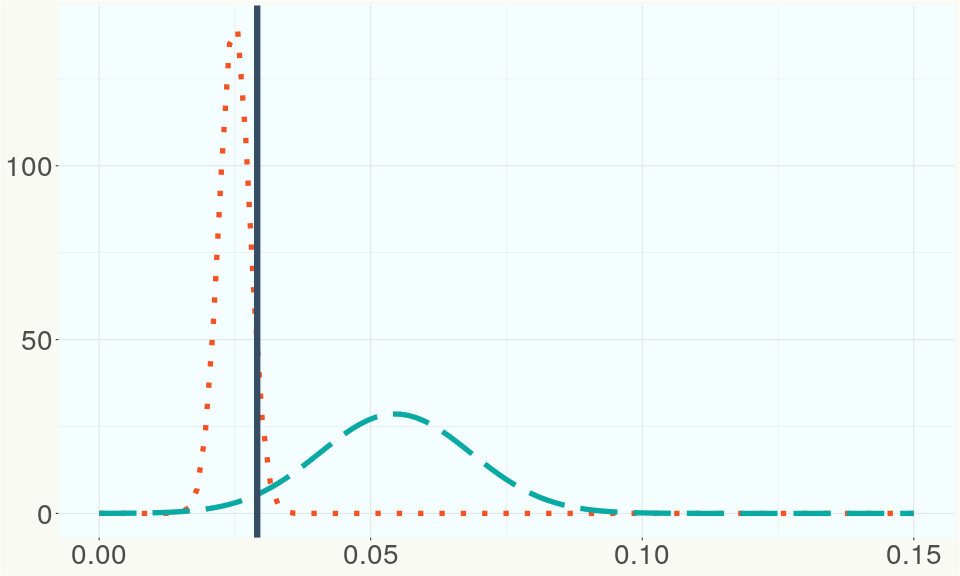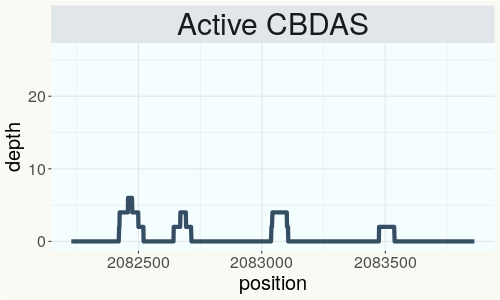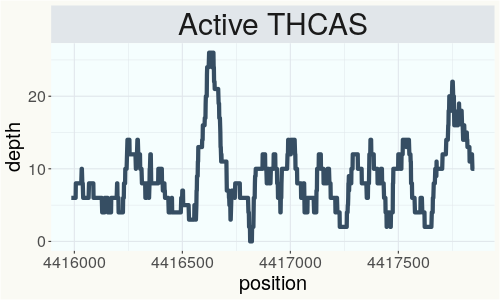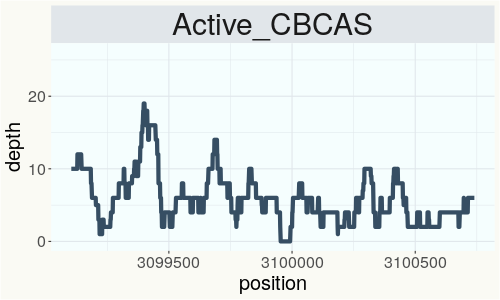BCP Lf-MET
RSP 13190
Grower: Zamir Punja
General Information
- Sample Name
- BCP Lf-MET-20240730
- Accession Date
- August 7, 2024
- Reported Plant Sex
- Female
- Report Type
- Whole-Genome Sequencing
- Microbiome
- Krona Plot
- Fungal Microbiome
- Krona Plot
- Bacterial Microbiome
- Krona Plot
- Viral Microbiome
- Krona Plot
The strain rarity visualization shows how distant the strain is from the other cultivars in the Kannapedia database. The y-axis represents genetic distance, getting farther as you go up. The width of the visualization at any position along the y-axis shows how many strains there are in the database at that genetic distance. So, a common strain will have a more bottom-heavy shape, while uncommon and rare cultivars will have a visualization that is generally shifted towards the top.
Chemical Information
Cannabinoid and terpenoid information provided by the grower.
Cannabinoids
No information provided.
Terpenoids
No information provided.
Genetic Information
- Plant Type
- Type I
File Downloads
The bell curve in the heterozygosity visualization shows the distribution of heterozygosity levels for cannabis cultivars in the Kannapedia database. The green line shows where this particular strain fits within the distribution. Heterozygosity is associated with heterosis (aka hybrid vigor) but also leads to the production of more variable offspring. When plants have two genetically different parents, heterozygosity levels will be higher than if it has been inbred or backcrossed repeatedly.
The ratio of reads mapped to Y-contigs to reads mapped to the whole Cannabis genome (Y-ratios) has been demonstrated to be strongly correlated with plant sex typing. This plot shows the distribution of Y-ratios for all samples in our database which were sequenced with the same method (panel or WGS) as this sample and where this sample falls in the distribution.

This chart represents the Illumina sequence coverage over the Bt/Bd allele. These are the three regions in the cannabis genome that impact THCA, CBDA, CBGA production. Coverage over the Active CBDAS gene is highly correlated with Type II and Type III plants as described by Etienne de Meijer. Coverage over the THCA gene is highly correlated with Type I and Type II plants but is anti-correlated with Type III plants. Type I plants require coverage over the inactive CBDA loci and no coverage over the Active CBDA gene. Lack of coverage over the Active CBDA and Active THCA allele are presumed to be Type IV plants (CBGA dominant). While deletions of entire THCAS and CBDAS genes are the most common Bt:Bd alleles observed, it is possible to have plants with these genes where functional expression of the enzyme is disrupted by deactivating point mutations (Kojoma et al. 2006).



This chart represents the Illumina sequence coverage over the CBCA synthase gene.

Variants (THCAS, CBDAS, and CBCAS)
No variants to report
Variants (Select Genes of Interest)
| PHL-2 | c.3467A>G | p.Gln1156Arg | missense variant | moderate | contig2621 | 343510 | A/G | |
| PHL-2 | c.3552delG | p.Lys1185fs | frameshift variant | high | contig2621 | 343593 | CG/C |
|
| PKSG-4b | c.316+2T>A | splice donor variant & intron variant | high | contig700 | 2723818 | A/T | ||
| AAE1-1 | c.456delA | p.Gly153fs | frameshift variant | high | contig606 | 3243814 | CT/C |
|
| DXR-2 | c.1319T>C | p.Ile440Thr | missense variant | moderate | contig380 | 285250 | A/G |
|
| ELF3 | c.772A>G | p.Ser258Gly | missense variant | moderate | contig97 | 242478 | A/G |
|
| ELF3 |
c.1803_1805d |
p.His601del | disruptive inframe deletion | moderate | contig97 | 244625 | ACAT/A |
|
| HDS-2 |
c.82_93delGT |
p.Val28_Thr3 |
conservative inframe deletion | moderate | contig95 | 1989748 |
CGTAACCGGAAC |
|
| HDS-2 | c.127T>G | p.Ser43Ala | missense variant | moderate | contig95 | 1989794 | T/G |
|
| HDS-1 | c.1618A>G | p.Ile540Val | missense variant | moderate | contig1891 | 885936 | T/C | |
| HDS-1 | c.1378G>A | p.Val460Ile | missense variant | moderate | contig1891 | 886370 | C/T |
|
| HDS-1 | c.136G>A | p.Val46Ile | missense variant | moderate | contig1891 | 889256 | C/T | |
| HDS-1 | c.56C>G | p.Ala19Gly | missense variant | moderate | contig1891 | 889336 | G/C | |
| HDS-1 |
c.-108+1_-10 |
splice donor variant & intron variant | high | contig1891 | 889975 | A/AC |
|
|
| FT | c.240C>G | p.Asn80Lys | missense variant | moderate | contig1561 | 3124664 | C/G |
|
| FLD | c.125G>A | p.Ser42Asn | missense variant | moderate | contig1450 | 2047909 | C/T | |
| PKSB-3 | c.1652A>G | p.Glu551Gly | missense variant | moderate | contig93 | 3339759 | A/G |
|
Nearest genetic relatives (All Samples)
- 0.087 BCP-St-NoMET (RSP13195)
- 0.088 BCP St-Fl (RSP13140)
- 0.091 BCP-Lf-NoMET (RSP13191)
- 0.092 BCP Buds (RSP13137)
- 0.093 BCP-St-MET (RSP13194)
- 0.094 BCP Lf-Fl (RSP13139)
- 0.097 BCP-Rt-NoMET (RSP13193)
- 0.097 BCP Rt-Fl (RSP13138)
- 0.098 BCP-Rt-MET (RSP13192)
- 0.110 Blch-Rt-RW (RSP13198)
- 0.122 BCP Dring (RSP13118)
- 0.145 Blch-Rt-Coco (RSP13197)
- 0.191 BCP-Stem-Fl2 (RSP13196)
- 0.230 Blch Buds (RSP13134)
- 0.232 Blch St-Fl (RSP13136)
- 0.232 Blch Rt-Fl (RSP13135)
- 0.232 D1 (RSP12875)
- 0.274 PG Buds (RSP13151)
- 0.275 T20G (RSP13091)
- 0.275 T20H (RSP13092)
Most genetically distant strains (All Samples)
- 0.486 Cherry Blossom (RSP11317)
- 0.463 Cherry Blossom (RSP11311)
- 0.458 Cherry Blossom (RSP11314)
- 0.456 Cherry Blossom (RSP11323)
- 0.451 Cherry Blossom (RSP11328)
- 0.448 Cherry Blossom (RSP11335)
- 0.446 Cherry Blossom (RSP11308)
- 0.446 Cherry Blossom (RSP11306)
- 0.446 Cherry Blossom (RSP11298)
- 0.445 Cherry Blossom (RSP11330)
- 0.441 Cherry Blossom (RSP11309)
- 0.439 Cherry Blossom (RSP11324)
- 0.437 Unknown- Cherry Wine - 003 (RSP11270)
- 0.437 Cherry Blossom (RSP11312)
- 0.437 Cherry Blossom (RSP11325)
- 0.435 Cherry Blossom (RSP11333)
- 0.435 Tiger Tail 30 (RSP11484)
- 0.435 Cherry Blossom (RSP11334)
- 0.433 CS (RSP11208)
- 0.433 Tanao Sri-white-T1 (RSP11658)
Nearest genetic relative in Phylos dataset
- Overlapping SNPs:
- 87
- Concordance:
- 57
Nearest genetic relative in Lynch dataset
- Overlapping SNPs:
- 14
- Concordance:
- 12
Blockchain Registration Information
- Transaction ID
-
RSP13190-mgc-ots
-certificate - Stamping Certificate
- Download PDF (1.2 MB)
- SHASUM Hash
-
31c8d9aa3a5d712d935ec3b93ca5705c fde1848ea578d197 d7b2630b7a304f0c